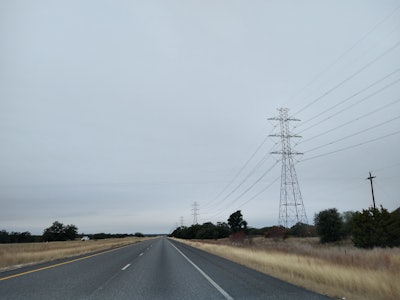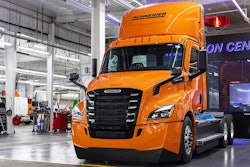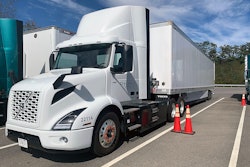
Texas epitomizes big. This fact preoccupied me driving the seemingly endless roads from Austin to El Paso. Somewhere just to the west of San Antonio on Interstate 10 — what seemed like only halfway across the map of Texas — I noticed that the green mile marker sign read 500. Meaning I still had 500 miles to go to El Paso and the border with New Mexico.
Meaning no affront to Texans that live out there, there is a lot of nothing between San Antonio and El Paso. At one point on my journey, the Texas Highway Department kindly mentions that the next availability of gas is 87 miles away. That gas is two lonely stations on opposite sides of an overpass in Bakersfield. No, not the one in California. A few miles more and you hit Fort Stockton.
These two lonely fuel stations are indicative of future electric truck station needs in big expanses like Texas. The geography lesson here is that distances between cities in Texas typically exceed 250 miles, and 250 just happens to be that magic number currently associated with maximum range of most of the commercially viable Class 8 electric tractors. By commercially viable, I mean they still can carry sufficient paying payload to make the same number of trips as the diesel truck they are replacing would make. The graphic below highlights my point on distances between major cities in the south-central U.S.

Getting closer to El Paso, I got to the point where I-10 and I-20 merge. It was Sunday, a lighter traffic day, so I could count trucks. I had a lot of time to count trucks. The eastbound lanes were averaging about 10 Class 8 trucks of various vocations per mile. The electronic map program says mileage between El Paso and Dallas is 635 miles, and El Paso to San Antonio is 551. The eastbound trucks I was counting were likely going to one of those cities. Simple math says 600 miles of trucks at 10 trucks per mile is 6,000 trucks, and 600 miles is also about right for miles achievable in an 11-hour driving day.
At 2 kWh/mi energy use typical of current Class 8 battery electric trucks, that means these routes need at least 7.2 GWh of electricity per day on this segment of road. I’ve lived in Texas a fair while, and know that the energy grid here has been strained both in winter and summer, operating at capacity repeatedly. So, this new load for electric vehicle transportation suggests new generation and distribution are needed.
Some other “back of the envelope” conclusions are that at 250 miles per charge — that magic number that battery electric trucks seem to be targeting — means at least two stops to recharge per truck on these routes. Assuming fast megawatt level chargers are able to recharge vehicles in under an hour, that still adds a couple hours to the driver’s day. That suggests that changes to the hours of service rules for operating battery electric trucks may be needed, just as the government has increased overall gross vehicle weight limits to 82,000 lbs. for them.
Let’s not forget little Bakersfield, Texas. The electric vehicle future will likely see new Bakersfields showing up on these routes because truck stops with sufficient power and parking space will be needed in areas that currently don’t have any towns. In the mid-1800s, in the old west, routing the railroad lines or the stagecoach lines inevitably required situating new towns along the way.
The electric future for trucks will likely see a similar real estate frenzy as the infrastructure builds out. Don’t think just about the charging points, which might be unstaffed, but restaurants, maintenance and repair facilities, workspaces, hotels, and power generation facilities, and support infrastructure to build and maintain those.
Boulder City, Nevada, is a great example of what one of these stops could turn into. Boulder was a desert prior to the Hoover Dam being located in the nearby canyon. It was created to support building the dam. Today, it is a thriving city powered by hydro-electric power from the Hoover dam, and also power from massive nearby solar farms.
The building of towns across the “wild west” tended to follow laying track for steam trains. Steam trains needed water and fuel frequently. As train technology matured the distance between fuel and water stops stretched out. Diesel-electric trains that entered the market in the 1940s eventually made long distances the norm between fuel stops, but the national highway system that came into being in parallel introduced long range trucks as well, also needing fuel stops. Predicting infrastructure locations is still a gamble as no one really controls the future of transportation.
The long road to the electrification of trucking will see new cities start. Some will later become ghost towns or isolated spots like Bakersfield, Texas. Others may become new versions of Boulder City, Nevada.
The point is that the investment has to occur. Those predictions have to start with breaking ground. The risks have to be taken. Paper studies can only go so far, and no one knows the future. We have to live it. The U.S. has endless success and failure stories, but we are where we are today because investment risk was taken.












